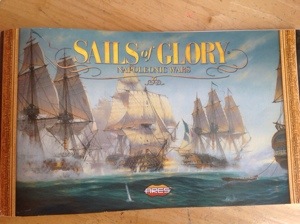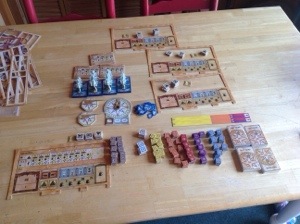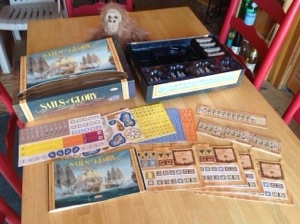Posts Tagged: combat games


Sails of Glory review

Sails of Glory is a miniatures based naval combat game from Ares Games that is a great way to fight ship to ship in the age of sail. The game has similar mechanics to Ares airplane game Wings of Glory or X-Wing from Fantasy Flight. Each player selects actions in secret and reveals what they are planning to do at the same time. Movement resolves at the same time and then players get to make a shoot/no shoot decision. Damage is resolved at the same time as well, so there’s always a risk you’ll take damage if you are within the range of enemy guns. You enter the reload phase and start the reloading process. Cannons that just fired are cleaned or empty cannons are reloaded. Just like in real life it takes time to reload your cannons. You continue repeating these steps: Plan, Move, Combat, Reload, until one side has surrendered or been driven off the map.
The starter set comes with four ships, a wind indicator, two attitude pointers, and a huge number of counters and tokens. The rule book is 63 pages and is section off into initial setup, basic, standard, advanced, optional rules and scenarios. It took about 45-60 minutes to punch out all the bits. It’s important to keep all the counters separated, especially the ship tokens. Each ship needs to have the same action tokens during advanced play. I can see it might be easy to toss all the ship related bits into a single bag, but if you play the advanced game you’ll have to spend some time sorting and counting to ensure you have the right number of action tokens per ship.
 Here is what my set looked like after punch out. Each ship has a ship board, that’s the mat in the lower left corner of the image. The large hole across the top fits a ship’s specific stats board. This is a neat design and allows you to take one of the stats boards from an expansion set ship and place it into the ship board. Damage, actions, and gun status (loaded or unloaded) are all represented on the board.
Here is what my set looked like after punch out. Each ship has a ship board, that’s the mat in the lower left corner of the image. The large hole across the top fits a ship’s specific stats board. This is a neat design and allows you to take one of the stats boards from an expansion set ship and place it into the ship board. Damage, actions, and gun status (loaded or unloaded) are all represented on the board.
All the letter/colored counters (A-E, Yellow-Blue) are damage counters. When you fire your cannons at an enemy your range and ammunition determine what tokens you use. You draw a number out of a cup or bag based on your attack rating and the enemy turns over the counters to see the damage. This is a cool mechanic because you dish out damage at the same time to anyone who was shot at in the round.
 My test game with Louis did not got well for me. We sailed around the table trying to get a first shot. I watch Master and Commander before playing this and took the small English ship where Louis wanted the large French ship. I proved to be no Jack Aubrey and got hammered with two broadsides before I could bring my guns to bear. After taking so much damage my shots were too little too late and her majesty lost a ship to those vile French. The basic game plays a lot like X-wing. You plan, move, shoot, reload and repeat. You have to watch the wind direction; it will determine what movement cards you can select in the plan phase and how effective the move turns out to be. Measuring is not done until you move or declare a shot so you may not know exactly if you are going to move as far as you want or hit your target. As your ship takes damage it becomes less capable and that makes it harder to do damage to the enemy.
My test game with Louis did not got well for me. We sailed around the table trying to get a first shot. I watch Master and Commander before playing this and took the small English ship where Louis wanted the large French ship. I proved to be no Jack Aubrey and got hammered with two broadsides before I could bring my guns to bear. After taking so much damage my shots were too little too late and her majesty lost a ship to those vile French. The basic game plays a lot like X-wing. You plan, move, shoot, reload and repeat. You have to watch the wind direction; it will determine what movement cards you can select in the plan phase and how effective the move turns out to be. Measuring is not done until you move or declare a shot so you may not know exactly if you are going to move as far as you want or hit your target. As your ship takes damage it becomes less capable and that makes it harder to do damage to the enemy.
 The one thing I was worried about with a game with SO MANY tokens is how to put it away. I was happy that there is a large cutout in the form under the rule book that holds most of the tokens in snack baggies. The wind gauge and indicators have their own spots in the form. The mats and rulers fit in the large space in the upper right. Each deck and ship fits in its own space. It’s very nice to have a game with so many bits fit back in the original box and not require special extra boxing (I’m looking at you X-Wing Fantasy Flight!) The next time this hits the table I am going to try out the standard rules, which adds a little more complexity by giving the player an option for ammo to load (chain and grape shot) and creates more realism in planning phase by creating a two step process where you select a move for the next turn. This requires you to plan two steps at a time because a ship doesn’t respond as quickly as a plane or a TIE fighter.
The one thing I was worried about with a game with SO MANY tokens is how to put it away. I was happy that there is a large cutout in the form under the rule book that holds most of the tokens in snack baggies. The wind gauge and indicators have their own spots in the form. The mats and rulers fit in the large space in the upper right. Each deck and ship fits in its own space. It’s very nice to have a game with so many bits fit back in the original box and not require special extra boxing (I’m looking at you X-Wing Fantasy Flight!) The next time this hits the table I am going to try out the standard rules, which adds a little more complexity by giving the player an option for ammo to load (chain and grape shot) and creates more realism in planning phase by creating a two step process where you select a move for the next turn. This requires you to plan two steps at a time because a ship doesn’t respond as quickly as a plane or a TIE fighter.
